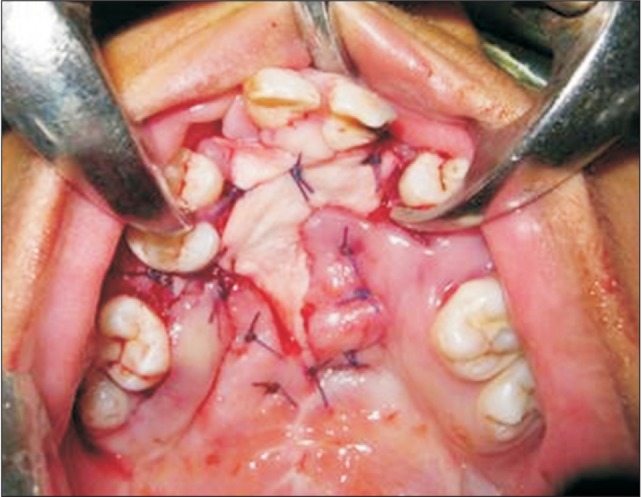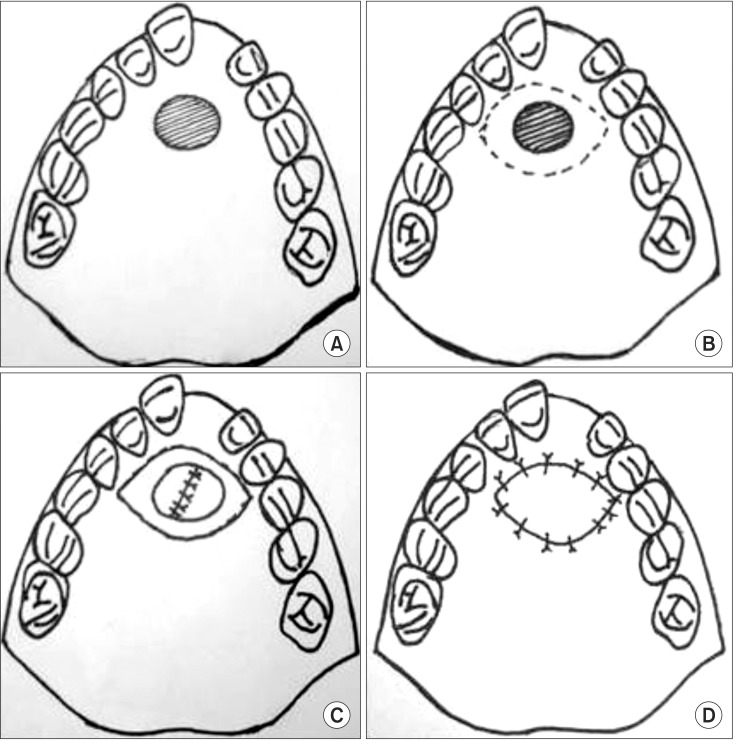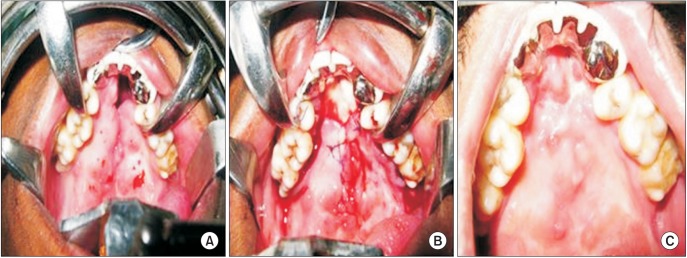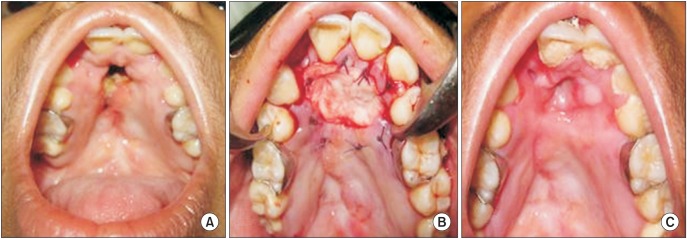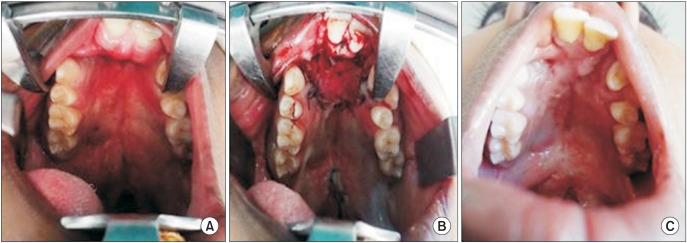J Korean Assoc Oral Maxillofac Surg.
2016 Apr;42(2):77-83. 10.5125/jkaoms.2016.42.2.77.
Use of regenerative tissue matrix as an oral layer for the closure of recalcitrant anterior palatal fistulae: a pilot study
- Affiliations
-
- 1Richardsons Dental and Craniofacial Hospital, Nagercoil, India. sunilrichardson145@gmail.com
- 2Private Practitioner, Yakima, WA, USA.
- 3Division of Plastic and Reconstructive Surgery, Department of Surgery, Stanford University, Stanford, CA, USA.
- 4Sukriti Hospital, Bharuch, India.
- 5Godrej Memorial Hospital, Mumbai, India.
- KMID: 2351729
- DOI: http://doi.org/10.5125/jkaoms.2016.42.2.77
Abstract
OBJECTIVES
To evaluate the effectiveness of regenerative tissue matrix (Alloderm) as an oral layer for difficult anterior palatal fistula closure.
MATERIALS AND METHODS
The authors have tested the feasibility of a novel surgical technique of adding a regenerative tissue matrix (Alloderm) as an oral layer for closure of recalcitrant large anterior palatal fistulae and report the outcome of the first 12 patients in this pilot study. Patients with recurrent large fistula who otherwise would require either a local pedicled flap, free flap, or an obturator were treated with this technique and followed up for at least 6 months to monitor the progress of healing.
RESULTS
Of the 12 patients, 8 patients (66.7%) had complete closure of the fistula, and 2 patients (16.7%) showed reduction in size of the fistula to the extent that symptoms were eliminated, for an overall success rate of 83.3% (10/12 patients). Premature graft loss and recurrence of the fistula were noted in 2 patients (16.7%).
CONCLUSION
Alloderm provided an adequate barrier allowing healing to occur unimpeded and allowed closure of the palatal fistula. In our experience, this new technique using regenerative tissue matrix as an adjunct to the oral layer in large anterior palatal fistula has an advantage compared to other more invasive complex procedures and has been shown to provide satisfactory results.
MeSH Terms
Figure
Reference
-
1. Amaratunga NA. Occurrence of oronasal fistulas in operated cleft palate patients. J Oral Maxillofac Surg. 1988; 46:834–838. PMID: 3171742.
Article2. Cohen SR, Kalinowski J, LaRossa D, Randall P. Cleft palate fistulas: a multivariate statistical analysis of prevalence, etiology, and surgical management. Plast Reconstr Surg. 1991; 87:1041–1047. PMID: 2034725.3. Muzaffar AR, Byrd HS, Rohrich RJ, Johns DF, LeBlanc D, Beran SJ, et al. Incidence of cleft palate fistula: an institutional experience with two-stage palatal repair. Plast Reconstr Surg. 2001; 108:1515–1518. PMID: 11711920.
Article4. Abyholm FE, Borchgrevink HH, Eskeland G. Palatal fistulae following cleft palate surgery. Scand J Plast Reconstr Surg. 1979; 13:295–300. PMID: 545672.5. Rintala AE. Surgical closure of palatal fistulae: follow-up of 84 personally treated cases. Scand J Plast Reconstr Surg. 1980; 14:235–238. PMID: 7209409.6. Denny AD, Amm CA. Surgical technique for the correction of postpalatoplasty fistulae of the hard palate. Plast Reconstr Surg. 2005; 115:383–387. PMID: 15692340.
Article7. Jeffery SL, Boorman JG, Dive DC. Use of cartilage grafts for closure of cleft palate fistulae. Br J Plast Surg. 2000; 53:551–554. PMID: 11000068.
Article8. Wilhelmi BJ, Appelt EA, Hill L, Blackwell SJ. Palatal fistulas: rare with the two-flap palatoplasty repair. Plast Reconstr Surg. 2001; 107:315–318. PMID: 11214043.
Article9. Schwabegger AH, Hubli E, Rieger M, Gassner R, Schmidt A, Ninkovic M. Role of free-tissue transfer in the treatment of recalcitrant palatal fistulae among patients with cleft palates. Plast Reconstr Surg. 2004; 113:1131–1139. PMID: 15083012.
Article10. LifeCell website [Internet]. Bridgewater (NJ): LifeCell Corporation;cited 2011 Aug 10. Available from: http://www.lifecell.com.11. Butler CE, Prieto VG. Reduction of adhesions with composite AlloDerm/polypropylene mesh implants for abdominal wall reconstruction. Plast Reconstr Surg. 2004; 114:464–473. PMID: 15277815.
Article12. Baxter RA. Intracapsular allogenic dermal grafts for breast implant-related problems. Plast Reconstr Surg. 2003; 112:1692–1696. PMID: 14578804.
Article13. Clark JM, Saffold SH, Israel JM. Decellularized dermal grafting in cleft palate repair. Arch Facial Plast Surg. 2003; 5:40–44. PMID: 12533137.
Article14. Cole P, Horn TW, Thaller S. The use of decellularized dermal grafting (AlloDerm) in persistent oro-nasal fistulas after tertiary cleft palate repair. J Craniofac Surg. 2006; 17:636–641. PMID: 16877906.
Article15. Schultz RC. Management and timing of cleft palate fistula repair. Plast Reconstr Surg. 1986; 78:739–747. PMID: 3538077.
Article16. Sclafani AP, Romo T 3rd, Jacono AA, McCormick S, Cocker R, Parker A. Evaluation of acellular dermal graft in sheet (AlloDerm) and injectable (micronized AlloDerm) forms for soft tissue augmentation. Clinical observations and histological analysis. Arch Facial Plast Surg. 2000; 2:130–136. PMID: 10925439.17. Rhee PH, Friedman CD, Ridge JA, Kusiak J. The use of processed allograft dermal matrix for intraoral resurfacing: an alternative to split-thickness skin grafts. Arch Otolaryngol Head Neck Surg. 1998; 124:1201–1204. PMID: 9821920.18. Helling ER, Dev VR, Garza J, Barone C, Nelluri P, Wang PT. Low fistula rate in palatal clefts closed with the Furlow technique using decellularized dermis. Plast Reconstr Surg. 2006; 117:2361–2365. PMID: 16772942.
Article19. Kirschner RE, Cabiling DS, Slemp AE, Siddiqi F, LaRossa DD, Losee JE. Repair of oronasal fistulae with acellular dermal matrices. Plast Reconstr Surg. 2006; 118:1431–1440. PMID: 17051115.
Article20. Steele MH, Seagle MB. Palatal fistula repair using acellular dermal matrix: the University of Florida experience. Ann Plast Surg. 2006; 56:50–53. PMID: 16374096.
- Full Text Links
- Actions
-
Cited
- CITED
-
- Close
- Share
- Similar articles
-
- Postoperative Newbone Formation of Horizontal Semicircular Canal Fistulae in Chronic Otitis Media with Cholesteatoma
- Palatal fistula closure with lengthening of soft palate using a pedicled buccal fat and a buccinator flap: a case report
- Reconstruction of Wide Palatal Defect Using Mucoperiosteal Hinge Flap and Pushback Palatoplasty
- Reconstruction of palatal defect using palatal flap
- Development of Matrix Metalloproteinases-Mediated Extracellular Matrix Remodeling in Regenerative Medicine: A Mini Review

